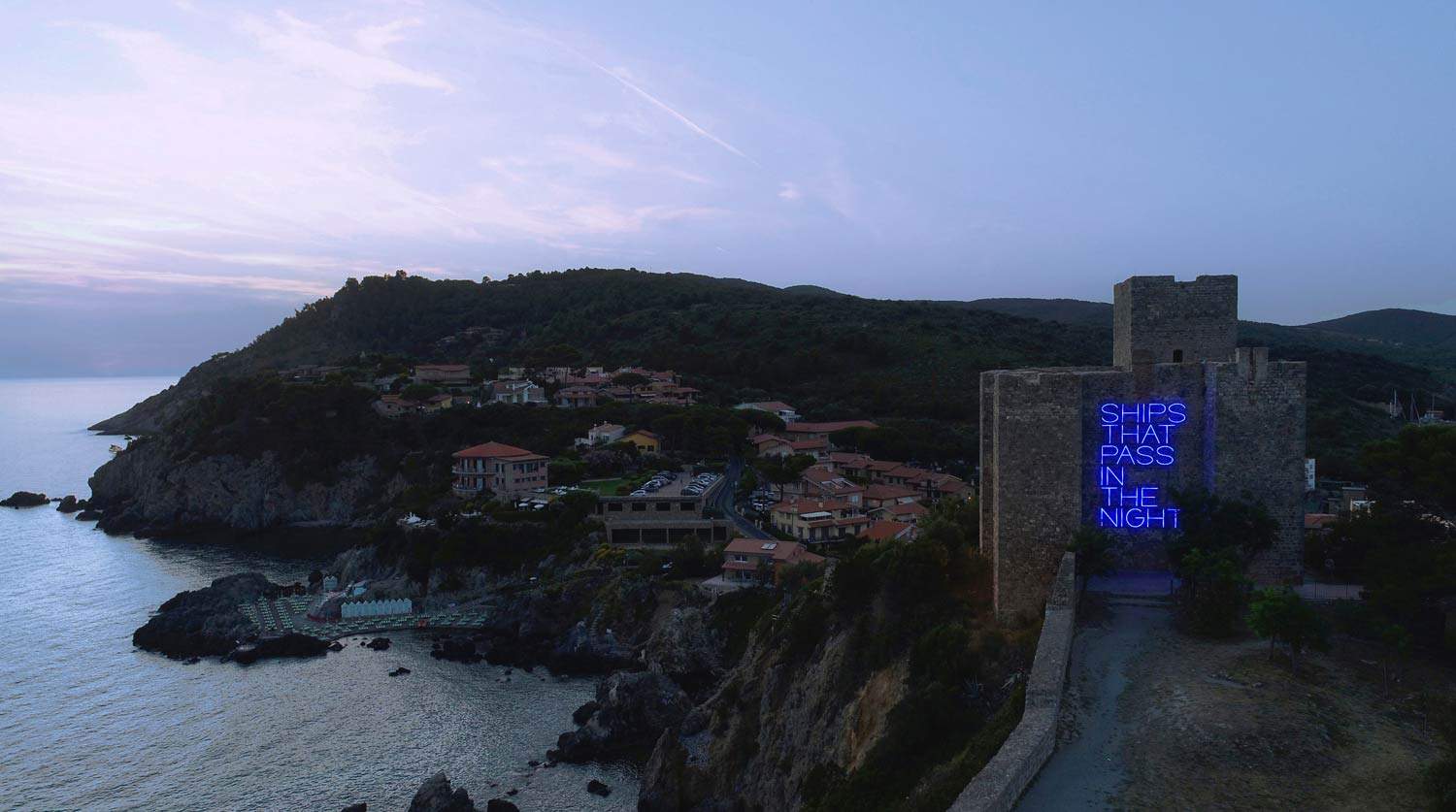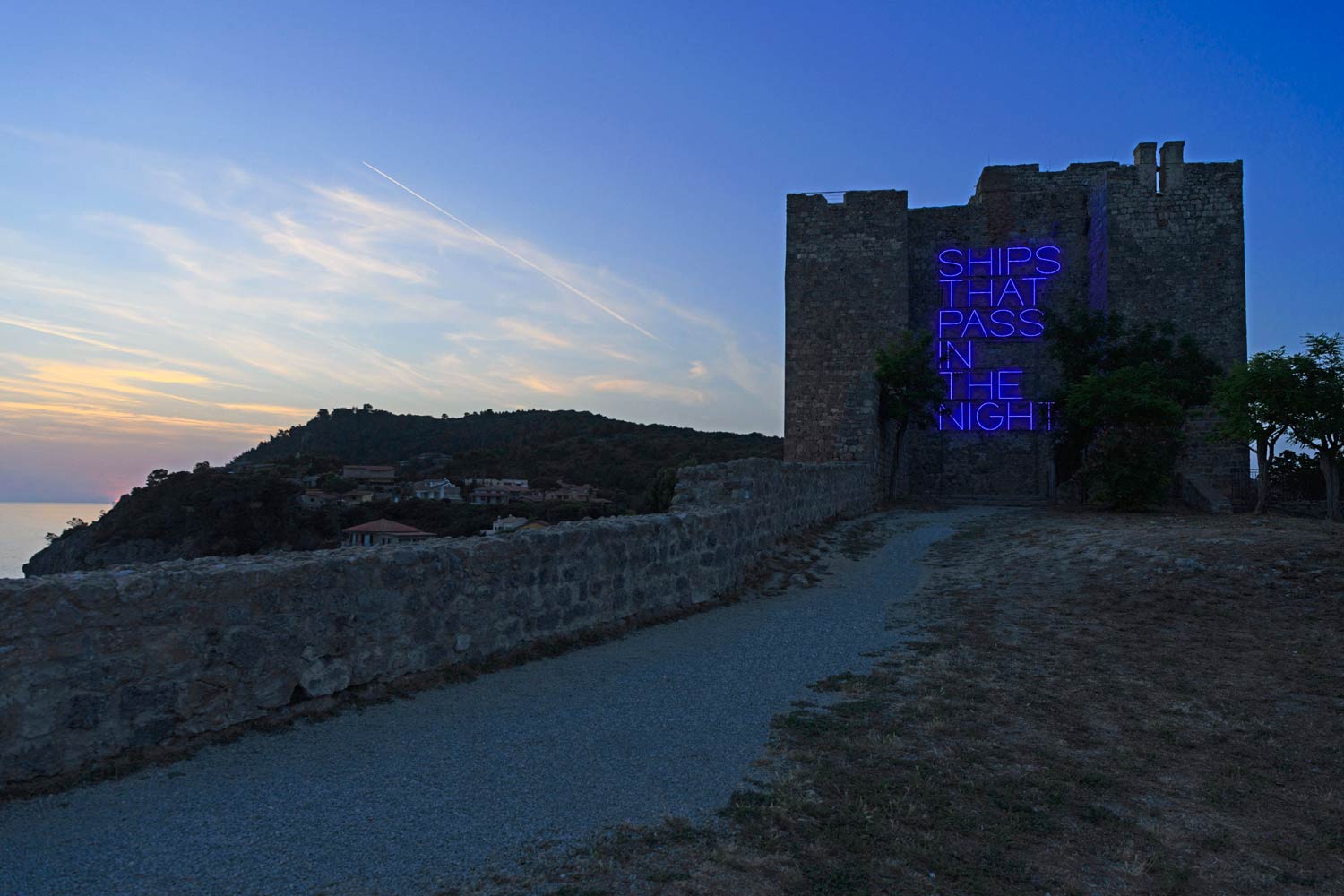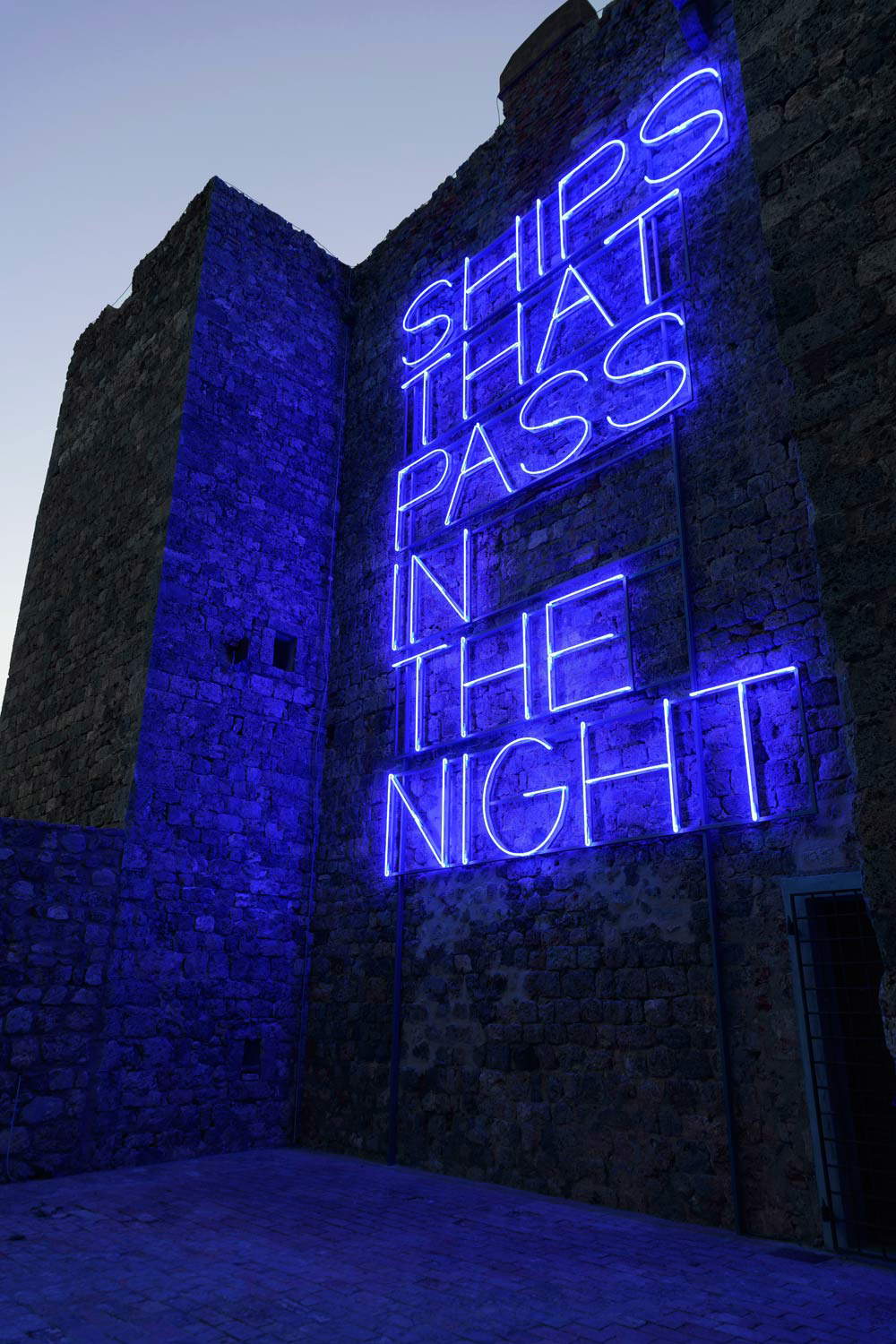It is titled Ships that pass in the night, the new site-specific installation that Maurizio Nannucci (Florence, 1939) conceived for the fourth edition of Hypermaremma, the exhibition of contemporary artworks inserted in the Maremma territory and born in 2019. The work stands on the facade of the Rocca Aldobrandesca in Talamone, with the aim of activating an intense dialogue with the history of the place.
The ancient medieval fortress, located overlooking the Maremma coast since the 12th century, hosts the work conceived as a point of contact between antithetical dualities: reality and vision, time and space, water and land; the same dichotomies on which the activities of nature and man have been based for centuries in the area marked by the bay of Talamone, a portion of territory halfway between sea and sky, between coastal and hilly landscape. The large neon work thus becomes part of the artist’s famous “writings,” capable of spreading words and phrases with imaginative power in a unique circuit that fluctuates between sign, color and meaning. Through the use of stained glass and fluorescent blue light, Nannucci intends to persuade the viewer to refine his or her visual perception, thus opening up an unprecedented dialogue between language and the spatial context in which it is placed.
Ships that pass in the night recounts the proximity of terrestrial space and the vastness of sea and sky. At night, the sea sinks into darkness, allowing night observers to catch glimpses of the luminous gleams of ships passing offshore: real ships bound for distant ports, or fantastic ships of dreams passing through the nights without a destination? Nannucci invites the viewer to turn his gaze to the sea through the message contained in the work positioned on land, following its double horizon and thus telling the story of sailors returning home. In the darkness of the night, the light of the work appears as a vision in the stillness of the Maremma landscape. By dedicating a poetic homage to the nocturnal sailors, the artist not only wants to offer them an unprecedented point of reference from the sea, but also aspires to evoke the rich historical and cultural heritage of the place as well.



“Maurizio Nannucci’s installation,” explains critic Lorenzo Bruni, "manifests itself through lettering that makes the understanding of the phrase Ships that pass in the night ’instantaneous and universal.’ This first impression is then succeeded, however, by the presence of the neon blue light that defines the phrase and expands its form, introducing us to an enigmatic dimension and to a slow, totally unexpected perception. This is how a sign and a linguistic code are transformed into an image and vice versa. Such conceptual and perceptual tensions, placed in dialectical contrast, also radically affect the meaning of the message, moving it into a territory open to multiple meanings. Not simply is the fact of a ship in the night emphasized; rather, the many mental images associated with all ships in history are evoked, layering in turn to potentially future ones. That is, imagery around the night and the dimension of dreaming is given substance, territory bordering on what can be considered certain or potential. What is called into play with this environmental intervention is directly the desire for the voyage, the happiness of sailors to see land again, the fear and curiosity of the unknown, to the dialogue that the viewer’s eye is led to institute there by looking back and forth between the horizon of the sea and the rock. This is not only a reflection on the philosophy of language and art, but on how all of us observers can contribute, in an active way, to that debate."
"The phrase Ships that pass in the night,“ Bruni points out, ”was first conceived by the artist in 1972 as a text arranged in a single line, like all the other statements in his famous ’anthology.’ Each time, however, Nannucci manages to create a perfectly site-specific work, as in the case of the composition conceived specifically for Talamone. In this case the message, in addition to opening by means of the neon tube to a meta-narrative and conceptual perspective, and not only informative, proposes the viewer to immerse himself in ’a live experience’. Experience instilled by the dialogue that the text creates between the viewer and the historical architecture of the fortress, capable of suggesting new mental processes with which to re-think, observe and experience it. Thus it is that the fortified outpost built in the Middle Ages as a defense against the presence of the stranger acquires, thanks to Nannucci’s intervention, a new function. That fortification, rather than being an impassable limit, becomes a place of encounter on both a mental and physical level. In fact, Nannucci’s intervention, minimal but full of poetry, leads the viewer to question not only the relationship between true and possible, dream and reality, image and concept, but also who takes responsibility for noticing the transit of that ship in the night, whether true or desired. The night that is called into question by the statement in question, on the other hand, is the moment when the instrument of sight for objective verification fails. The artist reminds us that the very night is the time of uncertainty, the condition that man has tried to de-power with artificial light and today with GPS systems. However, night is also an opportunity to begin again to imagine, and not just rationalize, the world. As the artist himself says: I thought of the blue neon light as a kind of interface between reality and vision, between culture and nature, between time and space.“ The installation, Bruni concludes, ”aims to make people analyze the nature of the language of art, but also the mechanism of solipsistic communication typical of the time of social media."
Maurizio Nannucci was born in Florence in 1939. He lives and works in Florence and Südbaden (Germany). One of the most important figures on the international art scene in recent decades, he has placed at the center of his work a conspicuous array of creative practices, ranging from artist’s books to multiples, sound works, photography and video, and numerous editions made in collaboration with other artists. From the mid-1960s to the present, through the constant practice of multiple expressive languages, he has extended his field of research beyond all disciplinary boundaries. In the mid-1960s Nannucci began to explore the multiple interrelationships between language, writing and images, drawing inspiration from concepts and ideas in linguistics, and using a wide range of media. In his research Nannucci developed an interdisciplinary approach by opening a network of collaborations in the fields of art, architecture and poetry. In addition to language, his interest turns strongly to color in all its manifestations. The documentation of linguistic research and experiences with color are the basis of a constant writing activity that Nannucci collected in anAnthology of neon blue texts still in progress (1967-2022...). From 1974 to 1985 he co-sponsored the activities of Zona non-profit art space in Florence and in 1998 was among the founders of Base / Progetti per l’arte. Nannucci carries out an intense publishing activity with the Exempla, Recorthings and Zona Archives editions, and has curated numerous exhibitions in museums, libraries and public institutions with documents from the archive. In the early 1990s he began to collaborate with architects such as Fritz Auer, Mario Botta, Stephan Braunfels, Massimiliano Fuksas, Nicholas Grimshaw, and Renzo Piano, and has realized several projects for museums and public buildings. Maurizio Nannucci has been invited several times to the Venice Biennale, Documenta in Kassel and the biennials of São Paulo, Sydney, Istanbul and Valencia. His works have been exhibited in more than three hundred museums and galleries, and are part of collections around the world, including the Guggenheim Foundation in Venice, the Staedtische Galerie im Lenbachhaus in Munich, the Berliner Museen and the Kunstsammlung des Deutschen Bundestages in Berlin, the Maxxi in Rome, the Museum of Fine Arts in Boston, the Centre Georges Pompidou and CNAP in Paris, MCA in Sydney, Museo del Novecento, Florence, Palazzo della Pilotta, Parma, City Life, Milan.
 |
| A large neon light on the Fortress of Talamone. Maurizio Nannucci's work for Hypermaremma. |
Warning: the translation into English of the original Italian article was created using automatic tools. We undertake to review all articles, but we do not guarantee the total absence of inaccuracies in the translation due to the program. You can find the original by clicking on the ITA button. If you find any mistake,please contact us.